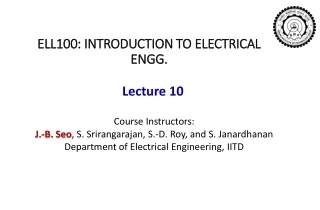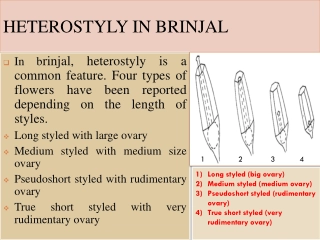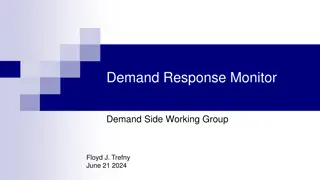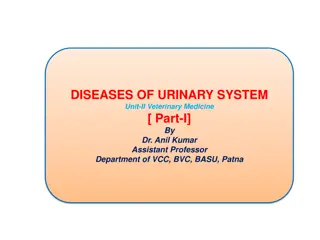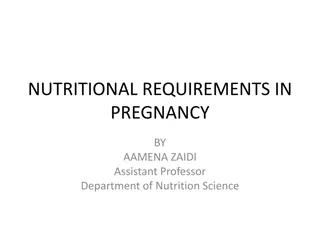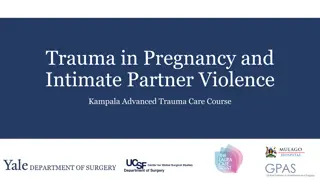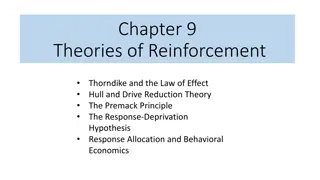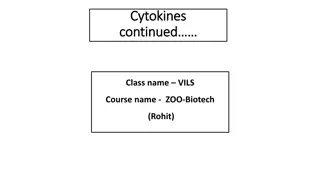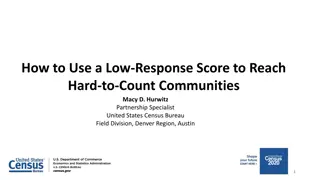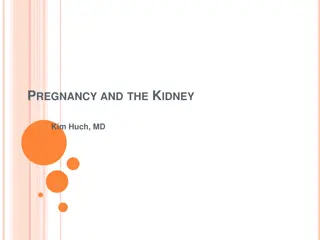Introduction to Electrical Engineering: Complete Response
Introduction to the concept of complete response in electrical engineering, covering natural response, forced response, and the addition of both components. The lecture also includes examples and step responses of RL and RLC circuits.
13 views • 65 slides
Understanding Heterostyly and Physiological Disorders in Brinjal
Heterostyly in brinjal involves four types of flowers with varying styles impacting fruit setting, while physiological disorders like poor fruit set, calyx withering, and freezing injury can affect the crop's productivity. Controlling measures for each disorder are discussed to help manage these iss
0 views • 10 slides
Emergency Nutrition Response in Sudan - GNC Partners Call
The GNC partners called for an emergency nutrition response in Sudan on August 23, 2023. The agenda included updates on the situation in Sudan, response strategies, operational challenges, funding gaps, and upcoming priorities. Details on the nutrition situation pre-conflict, acute malnutrition stat
6 views • 29 slides
Emergency Response Proposed Rule - Worker Safety and Health Conference
The Emergency Response Proposed Rule aims to update regulations for worker safety and health, expanding coverage to include technical search and rescue and emergency medical service entities. The rule proposes replacing the existing Fire Brigades standard with an Emergency Response standard. Federal
2 views • 23 slides
Comprehensive Guide to Initial Operational Response (IOR) in Hazardous Substance Incidents
This guide outlines the objectives, principles, and key elements of Initial Operational Response (IOR) to incidents involving hazardous substances or CBRN materials. It covers the stages of response, transition to Specialist Operational Response (SOR), primary objectives of IOR, JESIP principles, an
4 views • 25 slides
Online Consumer Complaint Filing and Response Process in India
Learn how to file a consumer complaint online and write a response as an opposite party in Consumer Forums of India through the Edaakhil portal. Understand the steps for registration, login, and filing a response for approved complaints and responses. Discover how to search for cases and access case
4 views • 15 slides
Rapid NHS Response Teams: Enhancing Home Care and Avoiding Hospital Admissions
Somerset Foundation Trust Community offers a comprehensive range of services, including Rapid Response, Urgent Community Response (UCR), and Hospital@Home (H@H). These services aim to provide timely and effective care to individuals in their homes, reducing the need for hospital admissions. Rapid NH
15 views • 6 slides
Understanding Pulmonary Circulation and V/Q Ratio in Respiratory Physiology
Explore the high-pressure and low-pressure circulations supplying the lungs, the concept of physiological shunt in pulmonary circulation, different lung zones based on blood flow, V/Q ratio and its clinical significance, and abnormal V/Q ratio patterns. Delve into the role of pulmonary circulations
11 views • 28 slides
Enhanced Demand Response Monitoring for ERCOT Operator
ERCOT aims to enhance its demand response monitoring capabilities through the implementation of a proposed Demand Response Monitor. The monitor will enable operators to better understand real-time demand response patterns and predict future needs, ultimately improving reliability and reducing the ne
1 views • 6 slides
Understanding Physiological and Pathological Types of Occlusion
This lecture discusses the physiological types of occlusion, focusing on facial and jaw signs to determine correct harmonious occlusion. It explains characteristics of orthognathic bite, straight bite, physiological biprognathism, and opisthognathic bite, highlighting key features such as tooth alig
1 views • 34 slides
Enhancing ERCOT's Capacity Assessment with Demand Response Monitoring
Demand response in ERCOT has been increasing, with forecasts of continued growth. The system operator can identify MW peaks by analyzing total ERCOT load data. A proposed Demand Response Monitor would assist in predicting future capacity needs based on responses from loads like LMP energy prices and
0 views • 7 slides
Understanding Urinary System Function in Veterinary Medicine
The urinary system in veterinary medicine involves the anatomy and physiological functions of maintaining body fluid composition and volume. Key processes like urine production, filtration, reabsorption, and regulation through nephrons play vital roles in maintaining overall health. This article cov
0 views • 14 slides
Understanding Nutritional Requirements in Pregnancy by Aamena Zaidi
Adequate nutrition before and during pregnancy is crucial for long-term maternal and fetal health. Maternal health is influenced by genetic, social, and economic factors, impacting physiological adaptations for better nutrient utilization. Physiological changes in pregnancy include increased total p
0 views • 41 slides
Understanding Trauma in Pregnancy and Intimate Partner Violence
Pregnancy introduces unique challenges in trauma care due to anatomical and physiological changes. Major physiological alterations impact injury patterns and responses, necessitating specialized management strategies. Blunt trauma incidents during pregnancy, including motor vehicle crashes and falls
1 views • 33 slides
Importance of Transport System in Animals for Oxygen Supply
Animals require a transport system to meet tissue oxygen demands efficiently. The size limit for oxygen diffusion alone is around 1 mm due to the proportional increase in radius and diffusion properties. Blood is crucial for transporting oxygen, nutrients, waste products, cells, and heat, as well as
0 views • 17 slides
Understanding Community Lifelines and Core Response Capabilities for Stabilizing Communities
The National Response Framework aims to strengthen response actions by coordinating across the entire community to stabilize community lifelines. Community lifelines are critical services essential for human health, safety, and economic security. Stabilizing these lifelines is crucial during respons
2 views • 14 slides
Theories of Reinforcement in Behavioral Economics
Explore key theories of reinforcement including Thorndike's Law of Effect, Hull's Drive Reduction Theory, the Premack Principle, Response-Deprivation Hypothesis, and Behavioral Economics concepts such as Response Allocation. Learn about reinforcers as stimuli, primary and secondary reinforcers, the
2 views • 9 slides
Understanding the Significance of Cytokines in Immune Response
Cytokines play a crucial role in immune response activation and regulation. They are secreted by various cell types like lymphocytes, monocytes, and macrophages, exerting diverse biological functions, including immune system development, inflammatory response induction, and hematopoiesis regulation.
2 views • 12 slides
Emergency Response and Management Overview
Understanding emergency response involves defining terms like emergency, supervision, command, and coordination. This includes the objectives of emergency response operations, key characteristics, requirements for effective response, and stages of response such as warning, threat, incident, assessme
6 views • 15 slides
Understanding Physiological Disorders: Rheumatoid Arthritis and Coronary Heart Disease
Explore the causes, effects, and treatment of Rheumatoid Arthritis and Coronary Heart Disease as part of investigating physiological disorders. Delve into the impact on the physical, mental, and emotional health of service users. Gain insights into the diagnosis, treatment, and support necessary for
0 views • 27 slides
Role of Major Physiological Anions in the Human Body
Physiological anions such as chlorides, sulphates, bicarbonate, phosphates, and electrolytes play essential roles in maintaining various functions within the body. Chloride ions help in osmotic balance, charge balance, and acid-base balance. Sulphates are important for detoxification mechanisms and
0 views • 11 slides
Understanding Quantitative Aspects of Drug Action
Explore the quantitative aspects of drug action, including drug receptor binding, concentration binding curves, dose-response curves, and types of antagonism. Learn to relate drug concentration to receptor binding capacity and response produced. Discover how concentration binding curves and dose-res
0 views • 29 slides
National Response Center Operations Overview
Established as a vital support entity in the National Response System, the National Response Center (NRC) serves as the federal contact point for pollution incident reporting. Handling various responsibilities such as coordinating responses to pollution, railroad, and port security incidents, the NR
0 views • 11 slides
Understanding Basis Functions and Hemodynamic Response Functions in fMRI Analysis
This content discusses the use of basis functions, parametric modulation, and correlated regressors in the first-level analysis of fMRI data processing. It delves into the concept of temporal basis functions for modeling complex functions of interest, such as the canonical hemodynamic response funct
1 views • 26 slides
Understanding Ageing and its Impact on Health and Social Well-being
Explore the physiological, social, and emotional aspects of ageing in healthcare. Learn about the ageing process, demographic changes, physiological effects, physical diseases, and social impacts on older individuals. Gain insights into the holistic needs of older people and the challenges they face
0 views • 86 slides
Tips for Cambridge IGCSE Paper 2 Extended Reading Response
Develop your response effectively for Cambridge IGCSE Paper 2 Extended Reading by following these top tips: read the passage, deconstruct the question, skim for relevant ideas, determine writing style and audience, plan your response using highlighters, and focus on content and quality of writing. S
1 views • 26 slides
Guidelines on EPA Region 9 Response Action Levels for TCE Contamination
EPA Region 9 has established response action levels for TCE contamination, with tiered concentrations for different exposure scenarios. The State of California provides guidance aligned with these levels. DTSC concurs with EPA's residential and industrial response levels but recommends consultation
0 views • 10 slides
Strategies for Reaching Hard-to-Count Communities Using Low-Response Score
Explore how to leverage a low-response score to engage with hard-to-count communities effectively. Learn about ROAM mapping tool, the 2020 Census goal, and the significance of Low Response Score (LRS) in identifying areas for targeted outreach. Discover hard-to-count variables and how to utilize dat
0 views • 14 slides
Methods and Devices for Detection of Deception
Various methods and devices are used for the detection of deception, including physiological responses recording, drug usage, hypnotism, observation, scientific interrogation, and confession. Deceptive behaviors manifest in verbal responses, posture changes, gestures, movements, and facial expressio
0 views • 20 slides
Impact of Number of Contact Attempts on Response Rates in Multimode Surveys
This meta-analysis investigates the effects of the number of contact attempts on response rates and web completion rates in multimode surveys. Benefits of multimode surveys include improving coverage, increasing response rates, reducing costs, and enhancing measurement accuracy by utilizing multiple
0 views • 27 slides
Understanding Renal Clearance and its Physiological Mechanisms
This content delves into the concept of renal clearance, exploring its relation to lipophilicity and mechanisms such as glomerular filtration, tubular secretion, and reabsorption. The processes occurring at the nephron level and the vascularization scheme are detailed, along with a breakdown of phys
0 views • 31 slides
Understanding the Biochemistry of Insect Hemolymph
Insect hemolymph, also known as blood, plays a crucial role in maintaining the tissues throughout the body. It consists of plasma containing hemocytes suspended in a fluid rich in various chemicals. The pH of the hemolymph ranges between 6.4 and 6.8, with variations in volume across different insect
0 views • 9 slides
Physiological Changes During Pregnancy: A Detailed Overview
Explanation of physiological changes in pregnancy including genital, breast, blood volume, and composition, as well as skin changes. Details on changes in the uterus, breast size, blood circulation, hormones, gastrointestinal motility, skin pigmentation, and more are covered.
0 views • 51 slides
Enersponse Inc. Demand Response Programs Summary
Enersponse Inc. is a Demand Response Aggregator managing a large number of commercial, industrial, agricultural, and municipal water pumping locations in North America. They utilize a DERMs platform and various software integrations to manage customer participation efficiently. The company actively
0 views • 21 slides
Vibration Response Spectrum Analysis for SDOF Systems
This article covers the calculation of the Vibration Response Spectrum for Single-Degree-of-Freedom (SDOF) systems subjected to base excitation using a general method equation. It explains how to determine the response for a family of natural frequencies and plot the results as VRS. The content incl
0 views • 16 slides
Study on Physiological Functions Using Chronophotographic Gun
Étienne-Jules Marey's pioneering work in time-resolved photography for studying physiology inspires a proposal for a quantitative analysis of physiological functions using similar techniques. The project involves analyzing videos to study postures, locomotion, and other important physiological para
0 views • 7 slides
Understanding Bodies: Beyond Physiological Container to Social Construct
Bodies are viewed through two contrasting lenses - materialist as a physiological container and social as a construct filled with possibilities. Bruce Henderson's exploration in "Queer Studies: Beyond Binaries" delves into the complexities of transgender and intersex lives, challenging traditional p
0 views • 21 slides
Pregnancy and the Kidney: Physiological Changes and Considerations for Chronic Kidney Disease
GB, a 28-year-old woman with a history of FSGS, seeks advice on pregnancy. Physiological changes in pregnancy affect renal function, including increased renal flow and volume, ureteral dilation, and systemic vasodilation. Renal hemodynamics peak in the first trimester without causing kidney damage.
0 views • 36 slides
Understanding Stress Response and its Impact on the Body
Stressful situations trigger a cascade of physiological changes known as the "fight-or-flight" response. The body's hormonal and physiological reactions help in coping with threats, but overreactions to non-life-threatening stressors can occur. The brain's command center, the hypothalamus, communica
0 views • 10 slides
Privacy Concerns Surrounding Galvanic Skin Response Bracelets in Education
The use of Galvanic Skin Response (GSR) bracelets in classrooms to measure physiological engagement has raised privacy concerns. Critics fear a dystopian future where students and teachers are monitored and controlled through electronic devices, leading to questions about common sense, funding sourc
0 views • 35 slides
